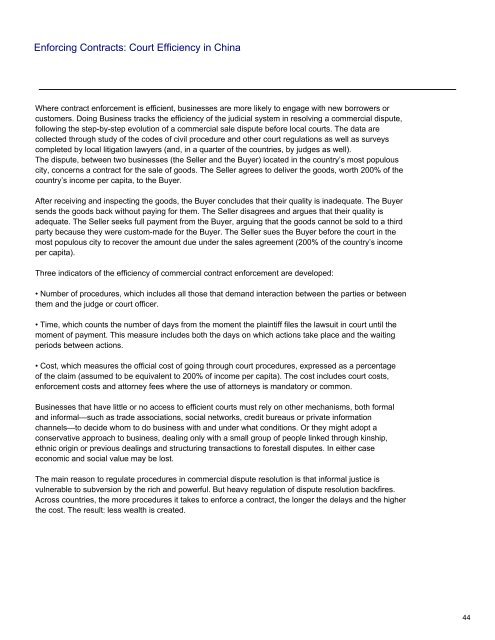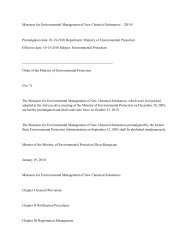View full report - NEEC
View full report - NEEC
View full report - NEEC
- No tags were found...
You also want an ePaper? Increase the reach of your titles
YUMPU automatically turns print PDFs into web optimized ePapers that Google loves.
Enforcing Contracts: Court Efficiency in ChinaWhere contract enforcement is efficient, businesses are more likely to engage with new borrowers orcustomers. Doing Business tracks the efficiency of the judicial system in resolving a commercial dispute,following the step-by-step evolution of a commercial sale dispute before local courts. The data arecollected through study of the codes of civil procedure and other court regulations as well as surveyscompleted by local litigation lawyers (and, in a quarter of the countries, by judges as well).The dispute, between two businesses (the Seller and the Buyer) located in the country’s most populouscity, concerns a contract for the sale of goods. The Seller agrees to deliver the goods, worth 200% of thecountry’s income per capita, to the Buyer.After receiving and inspecting the goods, the Buyer concludes that their quality is inadequate. The Buyersends the goods back without paying for them. The Seller disagrees and argues that their quality isadequate. The Seller seeks <strong>full</strong> payment from the Buyer, arguing that the goods cannot be sold to a thirdparty because they were custom-made for the Buyer. The Seller sues the Buyer before the court in themost populous city to recover the amount due under the sales agreement (200% of the country’s incomeper capita).Three indicators of the efficiency of commercial contract enforcement are developed:• Number of procedures, which includes all those that demand interaction between the parties or betweenthem and the judge or court officer.• Time, which counts the number of days from the moment the plaintiff files the lawsuit in court until themoment of payment. This measure includes both the days on which actions take place and the waitingperiods between actions.• Cost, which measures the official cost of going through court procedures, expressed as a percentageof the claim (assumed to be equivalent to 200% of income per capita). The cost includes court costs,enforcement costs and attorney fees where the use of attorneys is mandatory or common.Businesses that have little or no access to efficient courts must rely on other mechanisms, both formaland informal—such as trade associations, social networks, credit bureaus or private informationchannels—to decide whom to do business with and under what conditions. Or they might adopt aconservative approach to business, dealing only with a small group of people linked through kinship,ethnic origin or previous dealings and structuring transactions to forestall disputes. In either caseeconomic and social value may be lost.The main reason to regulate procedures in commercial dispute resolution is that informal justice isvulnerable to subversion by the rich and powerful. But heavy regulation of dispute resolution backfires.Across countries, the more procedures it takes to enforce a contract, the longer the delays and the higherthe cost. The result: less wealth is created.44











